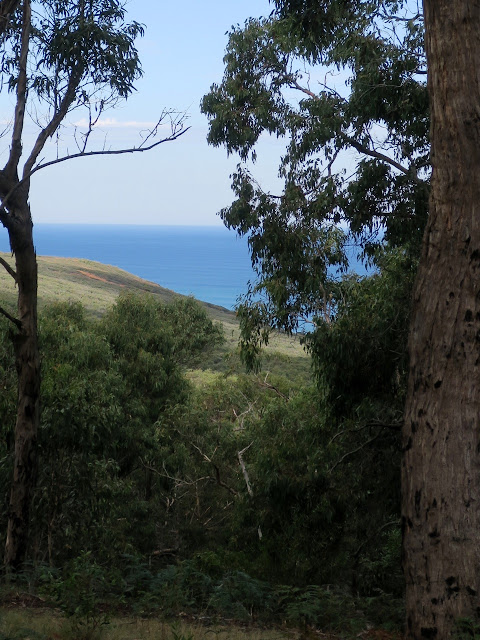While we were having a mid-morning cup of tea today we were visited by a pair of Crimson rosellas.
They came into the garden to feed on the seeds of the Rosemary Salvia rosemarinus bushes.
These are adults, the plumage of juvenile birds is mostly green.
It was warm and sunny a couple of days ago, so we took our daily walk in the Ironbark Nature Reserve.
This view through the trees is on elevated ground and in the distance the sea is visible.
Further along the path, the conspicuous headland of Point Addis, about two kilometres away, was bathed in sunlight.
I was curious to see what wild flowers would be out as we are now into autumn.
This is a small patch of Common Heath Epacris impressa, the floral emblem of Victoria state. It can be anything from white through to a rich red.
Nearby was another bell-shaped flower, Correa reflexa. Correas are a favourite indigenous plant and we have a number in our garden.
Above is a particularly healthy looking bush in full flower that was beside the path.
In these days of physical distancing and our government's instruction to 'Stay at home' I have noticed that many ikebanists have taken to sharing their passion for ikebana and the botanical world on-line. I can only approve, having started my weekly blogging 9 years ago when I was in Tokyo as the third recipient of the Norman and Mary Sparnon Endowment scholarship.
In recent days I was pleased to receive these photos from two of my students.
Eugenia took this photo of a Dahlia beginning to open...
...... and here it is fully opened three days later. What rich colour.
Marisha created this freestyle slanting arrangement with garden 'prunings'.
In the garden at Torquay I had noticed a couple of late-forming pink Hydrangea flowers; and was pleased that the first came into full bloom before the onset of colder weather. On another bush, the old flowers had started to develop autumnal colour. I decided to use both in one ikebana because of the interesting contrast between the new and fading flowers. When I picked two of the old flowers I also noticed the leaves colouring beautifully.
I arranged the two fading flowers with the fresh pink one and a twisting Moonah Melaleuca lanceolata branch in a tall woodfired ceramic vase by Graeme Wilkie.
I was somewhat frustrated and dissatisfied with the result. It took a little while to realise my mistake. My original intention had been subverted because I was distracted by the beauty of the leaves. They were not the intended subject and the contrast between the two stages of the flowers had been diminished.
This is the second working of the materials. I think this ikebana is more harmonious and stronger. The contrast between the two stages of the flowers is much clearer.
Because I placed the ikebana in the niche in the living room it is seen through a wide angle. I have rotated the vase to show this view from the righthand side, which is usually the first view of the ikebana. The fresh new flower becomes the principal subject and the autumnal colouring of the other two flowers is revealed slowly. Usually, I think that to be successful ikebana should have only one principal subject, idea or focus.
My good wishes go especially to the members of the Wellington Branch in New Zealand where I would have been today had our circumstances not been changed by the Covid-19 virus.
Greetings from Christopher
4th April 2020













No comments:
Post a Comment